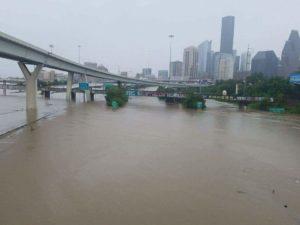Justifiably, people and the news media have celebrated the heroes of emergency response in Texas during the week-long nightmare of Hurricane Harvey. Disasters often bring out the best in many people, a selfless commitment that inspires those capable to rescue neighbors and even perfect strangers, binding a community together in a time of crisis. It is extremely important that we honor such people. Other people’s lives often depend on them. And not infrequently, they put their own lives at stake in the process.
But I have a concern, especially with the current administration and especially with the political leadership in Texas. My concern is that honoring these heroes will become a way of deflecting attention from the tough questions about how Houston and other communities exacerbated their own natural vulnerabilities and what long-term recovery planning will do about the situation. Is it enough just to rescue people, or do we need also to ask why so many were in harm’s way in the first place?
In the process of planning and implementing long-term recovery from Harvey, both Texas and the nation will need an entirely new brand of heroes. These will be the people who, despite the brickbats thrown at them from those who want to avoid the tough issues and continue business as usual, will have the courage to ask the tough questions and float ideas and solutions that others may not wish to entertain. As Larry Larson and David Conrad, two colleagues in floodplain management whose work I have admired for years, stated in the Washington Post in a September 1 op-ed column, we have known for nearly a quarter-century how to ameliorate flooding, dating back to the recommendations of a federal task force report that followed the Great Flood of 1993. We just have not done it. And Houston, in particular, despite ranking near the top nationally in flood damages, paid little heed. The lack of zoning and other land-use controls allowed development to pave over wetlands and other areas that could have served as natural drainage systems.
But the tough slog for sensible solutions will not be unique to Texas. It happened in New Jersey after Sandy, in Louisiana and Mississippi after Katrina, in Iowa after the 2008 floods, and so on, and so on. It goes with the territory. It helps explain why we keep suffering one major disaster after another. Sometimes, advocating for change can be a thankless job. It can also make a crucial difference in advancing solutions to address natural hazards and climate change.
What we will need are public policy champions. These people will turn over rocks, examine alternatives, and ask why we cannot do a better job of protecting the natural systems that can mitigate flooding, wind damage, and other hazards. These are the people, armed with science and common sense and determination, who fought for building codes and levee management reform after Katrina, for dune restoration after Sandy, for rebuilding a green community in Greensburg, Kansas, after an EF-5 tornado, and for a charter amendment to ensure a more effective master plan in New Orleans.
Already, these people have a critical mission ahead. Just days before Harvey made landfall in Texas, President Donald Trump revoked an Obama executive order that had facilitated the adoption of the Federal Flood Risk Management Standard, which outlined means for incorporating the science of climate change into estimations of flood risk used to determine what sorts of federal investments in infrastructure may occur in floodplains, and what standards they must comply with. This is undoubtedly part of the Trump war on the very idea of climate change, but the foolhardiness of this rush to undo the Obama legacy became clear as we watched the impact of Harvey on the Texas coast. The Trump administration had earlier proposed cutbacks in funding for the Federal Emergency Management Agency, whose help in Texas is now sorely needed, and gutting the funding for the floodplain mapping program, which, if anything, needs substantial new investment of at least $7 billion to modernize and update maps that are often sorely out of date. (Note that we are now talking about recovery funding for Harvey of as much as $180 billion.) There are other hazard mitigation issues on the front burner for federal consideration, but these are central.
And amid all this drama, recovery from Harvey will unfold in Texas. The biggest disservice to the heroism of all those who rescued neighbors and strangers will be to force others to repeat such sacrifices in future storms in situations where damages and flooding could have been mitigated through better land-use solutions, better building codes, and other measures to address the current inadequacies.
I stated in my first blog post about Harvey that no city in North America could handle the amount of rain that befell cities like Houston, and that remains true. But it does not mean the problem needed to be as bad as it was. The sheer extent of the problem was in many ways the result of runaway development patterns that trampled natural defenses against flooding. We can honor the rescue heroes with more heroes who ask the big questions and insist on effective solutions. We need public policy champions who will rise to the recovery challenge.
Jim Schwab
